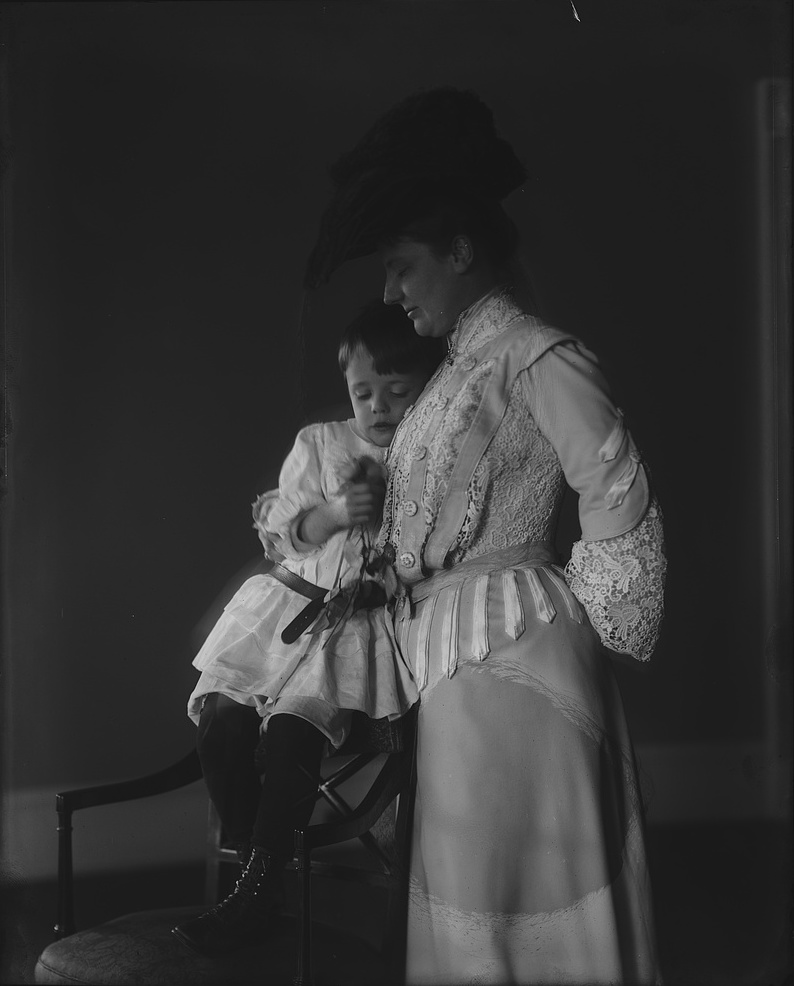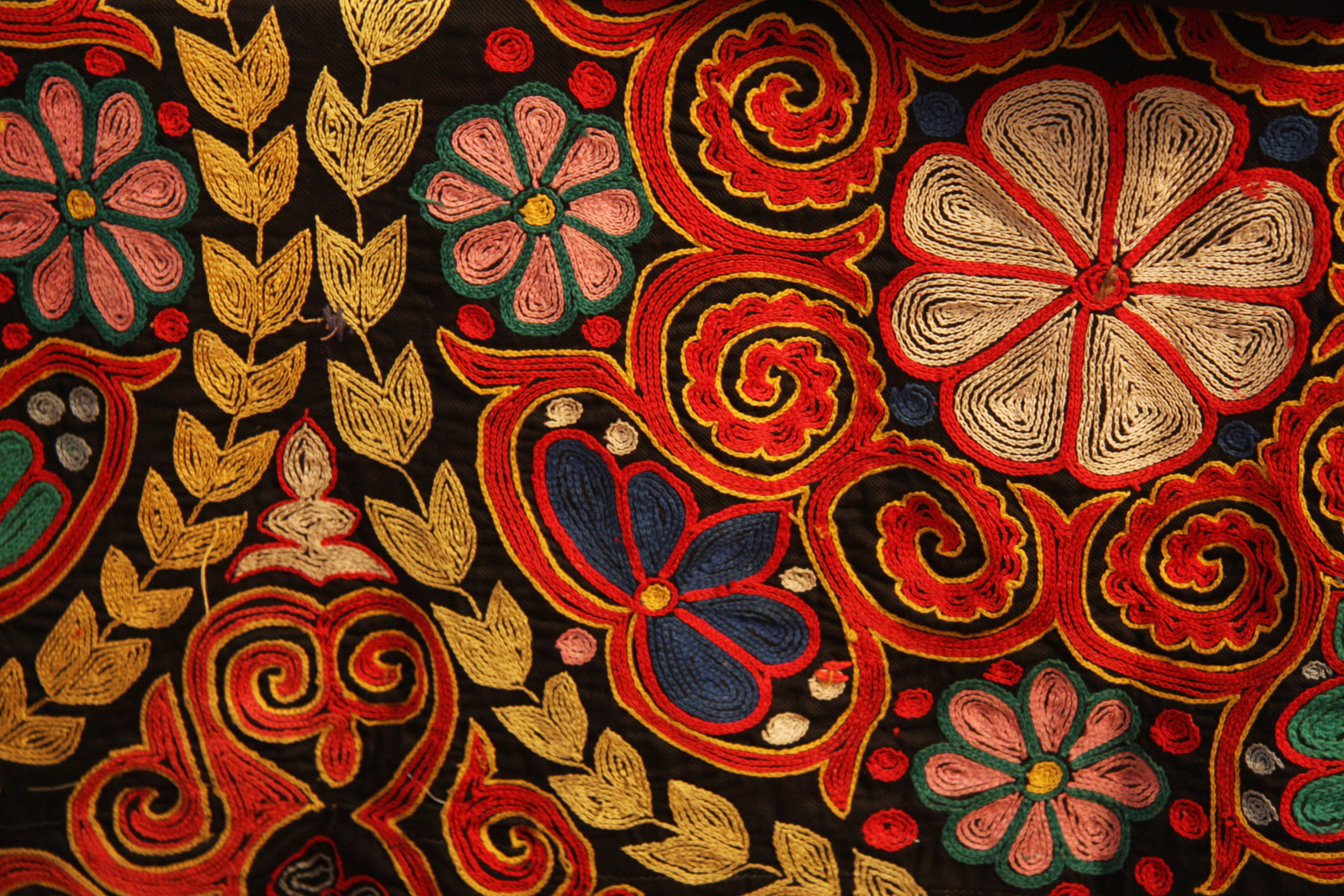|
Limerick Lace
Limerick lace is a specific class of lace originating in Limerick, Ireland, which was later produced throughout the country. It evolved from the invention of a machine which made net in 1808. Until John Heathcoat invented a net-making machine in Devon in 1815, handmade net was a very expensive fabric. This meant cheap net became available to Irish lacemakers, particularly after 1823 when Heathcoat's patent expired. Limerick lace is a hybrid lace of embroidered needle lace or crocheted lace on a machine made net base. It is a 'mixed lace' rather than a ‘true lace’, which would be entirely hand made. Limerick lace comes in two forms: tambour lace, which is made by stretching a net over a frame like a tambourine and drawing threads through it with a hook, and needlerun lace, which is made by using a needle to embroider on a net background. The lace was noted for its variety of delicate fillings, as many as 47 different ones being found in one collar. History The Limerick lace ... [...More Info...] [...Related Items...] OR: [Wikipedia] [Google] [Baidu] |
Edith Roosevelt
Edith Kermit Roosevelt (née Carow; August 6, 1861 – September 30, 1948) was the second wife of President Theodore Roosevelt and the First Lady of the United States from 1901 to 1909. She also was the Second Lady of the United States in 1901. Roosevelt was the first First Lady to employ a full-time, salaried social secretary. Her tenure resulted in the creation of an official staff and her formal dinners and ceremonial processions served to elevate the position of First Lady. Early life Edith was born on August 6, 1861, in Norwich, Connecticut, to merchant Charles Carow (1825–1883) and Gertrude Elizabeth Tyler (1836–1895). Gertrude's father Daniel Tyler (1799–1882) was a Union general in the American Civil War. Edith's younger sister was Emily Tyler Carow (1865–1939). Edith also had an older brother, Kermit (February 1860 – August 1860), who died one year before her birth. ''Kermit,'' her brother's first name and her middle name, was the surname of a paternal gre ... [...More Info...] [...Related Items...] OR: [Wikipedia] [Google] [Baidu] |
Needle Lace
Needle lace is a type of lace created using a Sewing needle, needle and yarn, thread to stitch up hundreds of small stitches to form the lace itself. In its purest form, the only equipment and materials used are a needle, thread and scissors. The origins of needle lace date back to the 16th century in Italy, and its origins may be found in the openwork on linen technique called ''reticella''. A variety of styles developed where the work is started by securing heavier guiding threads onto a stiff background (such as thick paper) with stitches that can later be removed. The work is then built up using a variety of stitches—the most basic being a variety of Buttonhole stitch, buttonhole or blanket stitch. When the entire area is covered with the stitching, the stay-stitches are released and the lace comes away from the paper. Needle lace is also used to create the fillings or insertions in cutwork. References * External links Kenmare Lace And other forms of Irish Lace- ... [...More Info...] [...Related Items...] OR: [Wikipedia] [Google] [Baidu] |
Basic Knitted Fabrics
Basic knitted fabrics include stocking stitch, reverse stocking stitch, garter stitch, seed stitch, faggoting, and tricot. In some cases, these fabrics appear differently on the right side (as seen when making the stitch) than on the wrong side (as seen from the other side, when the work is turned). Stockinette/stocking stitch and reverse stockinette stitch Stocking stitch (in US, stockinette stitch) is the most basic knitted fabric; every stitch (as seen from the right side) is a knit stitch. In the round, stocking stitch is produced by knitting every stitch; by contrast, in the flat, stocking stitch is produced by knitting and purling alternate rows. Stocking-stitch fabric is very smooth and each column ("wale") resembles a stacked set of "V"'s. It has a strong tendency to curl horizontally and vertically because of the asymmetry of its faces. Reverse stocking stitch is produced in the same way as stocking, except that the purl stitches are done on the right side and the kn ... [...More Info...] [...Related Items...] OR: [Wikipedia] [Google] [Baidu] |
Satin Stitch
In sewing and embroidery, a satin stitch or damask stitch is a series of flat stitches that are used to completely cover a section of the background fabric. Narrow rows of satin stitch can be executed on a standard sewing machine using a zigzag stitch or a special satin stitch foot. In order to maintain a smooth edge, shapes can be outlined with back, split or chain stitch before the entire shape including the outline is covered with satin stitch. Machine-made satin stitch is often used to outline and attach appliques to the ground fabric. Geography The satin stitch is a common form of needlework traditions worldwide; it is notable in North Africa, South America, Western Asia, Southeast Asia, Indian Subcontinent, and the Middle East. Satin stitch is also characteristic of Chinese embroidery. China Satin stitch is one of the two main types of Chinese embroidery stitches along with the Pekin knots. It is the most frequently used form of stitches in Chinese embroidery. F ... [...More Info...] [...Related Items...] OR: [Wikipedia] [Google] [Baidu] |
Blonde Lace
Blonde lace is a continuous bobbin lace from France that is made of silk. The term ''blonde'' refers to the natural color of the silk thread. Originally this lace was made with the natural-colored silk, and later in black. Most blonde lace was also made in black. It was made in the 18th and 19th centuries. The pattern, which is generally of flowers, is made with a soft silk thread, thicker than the thread used for the ground. This causes a big contrast between the flowers and the ground. It uses the same stitches as Chantilly lace and Lille lace, and is similarly made in strips 5 inches wide and invisibly joined. Blonde lace is not as good as Chantilly lace though, as the Bobbin lace ground, ground isn't as firm, nor is the pattern as regular. Blonde lace became very popular, and replaced Mechlin lace. It is very soft, and thus was well suited to the gathered trimmings fashionable during the nineteenth century. Blonde lace was used by royalty, and was worn in the portraits of the da ... [...More Info...] [...Related Items...] OR: [Wikipedia] [Google] [Baidu] |
Appliqué
Appliqué is ornamental needlework in which pieces or patches of fabric in different shapes and patterns are sewn or stuck onto a larger piece to form a picture or pattern. It is commonly used as decoration, especially on garments. The technique is accomplished either by hand stitching or machine. Appliqué is commonly practised with textiles, but the term may be applied to similar techniques used on different materials. In the context of ceramics, for example, an appliqué is a separate piece of clay added to the primary work, generally for the purpose of decoration. The term originates from the Latin ''applicō'' "I apply" and subsequently from the French ''appliquer'' "attach". History The term appliqué is derived from French and Latin verbs ''appliquer'' and ''applicare'', respectively, which both mean to join or attach. Like embroidery, it has a humble beginning. The technique was used as a way to strengthen worn areas of items or to patch holes that had formed. Early ap ... [...More Info...] [...Related Items...] OR: [Wikipedia] [Google] [Baidu] |
Needlerun Net
Needlerun Net is a family of laces created by using a needle to embroider on a net ground. Along with Tambour lace this became more popular with the advent of machine made netting. It is used in Limerick lace Limerick lace is a specific class of lace originating in Limerick, Ireland, which was later produced throughout the country. It evolved from the invention of a machine which made net in 1808. Until John Heathcoat invented a net-making machine in D .... References Needle lace Net fabrics {{Textile-arts-stub ... [...More Info...] [...Related Items...] OR: [Wikipedia] [Google] [Baidu] |
Chain Stitch
Chain stitch is a sewing and embroidery technique in which a series of looped stitches form a chain-like pattern. Chain stitch is an ancient craft – examples of surviving Chinese chain stitch embroidery worked in silk thread have been dated to the Warring States period (5th – 3rd century BC). Handmade chain stitch embroidery does not require that the needle pass through more than one layer of fabric. For this reason the stitch is an effective surface embellishment near seams on finished fabric. Because chain stitches can form flowing, curved lines, they are used in many surface embroidery styles that mimic "drawing" in thread. Chain stitches are also used in making tambour lace, needlelace, macramé and crochet. In Azerbaijan, in the Sheki region, this ancient type of needlework is called tekeldus. History The earliest archaeological evidence of chain stitch embroidery dates from 1100 BC in China. Excavated from royal tombs, the embroidery was made using threads of silk. ... [...More Info...] [...Related Items...] OR: [Wikipedia] [Google] [Baidu] |
Tambour Lace
In classical architecture, a tambour ( Fr.: "drum") is the inverted bell of the Corinthian capital around which are carved acanthus leaves for decoration. The term also applies to the wall of a circular structure, whether on the ground or raised aloft on pendentives and carrying a dome (also known as a tholobate), and to the drum-shaped segments of a column, which is built up in several courses. A cover made of strips of wood connected together with fabric such as that of a roll-top desk is called a tambour. This has been adopted to describe an office cupboard that is designed to have doors that conceal within the cabinet when opened, also known as roller-shutters. See also * Tholobate In architecture, a tholobate (from el, θολοβάτης, tholobates, dome pedestal) or drum is the upright part of a building on which a dome is raised. It is generally in the shape of a cylinder or a polygonal prism. In the earlier Byzanti ... Notes References * Columns and entab ... [...More Info...] [...Related Items...] OR: [Wikipedia] [Google] [Baidu] |
Charleville, County Cork
Charleville ( ga, Ráth Luirc or ''An Ráth'') is a town in north County Cork, Ireland. It lies in the Golden Vale, on a tributary of the River Maigue, near the border with County Limerick. Charleville is on the N20 road and is the second-largest town between Limerick and Cork, the largest being Mallow. The Roman Catholic parish of Charleville is within the Diocese of Cloyne. Significant industries in the town include Kerry Co-Op and the construction and services sectors. Names The old name for the place was Rathcogan, later Rathgogan or Rathgoggan, the last ( ga, Ráth an Ghogánaigh) still the name of the civil parish around the town. The name means Cogan's ''rath'' (ringfort), after the family of Miles de Cogan, granted lands there after the 12th-century Norman invasion. The new town begun by Roger Boyle, 1st Earl of Orrery in 1661 was named Charleville after Charles II, who had been restored to the throne the previous year. Later Irish speakers referred to the town as A ... [...More Info...] [...Related Items...] OR: [Wikipedia] [Google] [Baidu] |





.jpg)

